Jaw surgery, or orthognathic surgery, is performed to correct issues with the jaw and facial structure. This procedure can be done to correct a variety of conditions by aligning the jaws and teeth to improve the way they work and look.
It’s a long and arduous process, but we’ve prepared a selection of exercises to help you on the way!
🔎 Here’s a quick overview of all that’s revealed on this page:
- 📝The road to recovery after orthognathic surgery – how to manage the logistics.
- 📖 Best time to start exercising after jaw surgery – listen to your body and your doctor’s advice.
- 💪 Exercises for strengthening the jaw – the effects that different methods have on jawline strength and appearance.
Ready to learn what to do post-surgery? Let’s get straight into it!

The Road to Recovery After Orthognathic Surgery
Jaw surgery involves placing your jaw in a new position and aligning the bite. After this, all your facial muscles and the temporomandibular joints are left to adjust.
The healing process can take anywhere between 8 to 12 weeks after the procedure’s been done. It may be difficult initially, as there is a strict no-chewing rule for the first 6 weeks, and you can experience varying amounts of discomfort.
Patients don’t bounce back straight away, however, after around ten days, you can start exercises for a sore jaw and make improvements.
Remember that surgery isn’t the end of the road but merely one step along the way. You must still be informed on what you should do to get a better jawline and regularly practice the correct techniques.
The Right Time to Start Jaw Exercises After Jaw Surgery
After the surgery, you will experience pain and swelling around the area that was treated. You’ll have to wait until the wounds have healed a bit to be able to start light stretching exercises.
It’s recommended that you rest for ten days after surgery, and you likely won’t be allowed any type of activities in the first two weeks. After ten to fifteen days, you can slowly incorporate different movements to help your recovery. Choose the best jawline exercises for you, and never take on more than you can chew.
You can begin soft mewing very soon after the surgery with little to no problems. This is a great task to start with as it involves correct tongue posture and not much jaw movement, yet there’s still a mewing effect on your jawline.
You shouldn’t do anything that feels too painful, and you should always consult with your doctor before starting a new exercise. Don’t do anything if your physician thinks you’re not ready – they know what’s best for your individual case.
7 Exercises to Jaw Strengthening after a Jaw Surgery
Some proven practices will help you recover and restore the full function of your jaws. For example, correct tongue posture will help you keep the jaws aligned and open the airways for easier breathing. These are just some of all the benefits of mewing.
We’ve compiled a list of the best jaw-strengthening exercises to practice post-surgery. If you start slow, follow advice, and avoid any strenuous activities, you should slowly regain jaw function without any discomfort or side effects.
1. Do Exercises With the MewingCoach App
Mewing is a method used for maintaining proper tongue posture. It means that you should keep your tongue on the roof of the mouth at all times, as this is its natural resting position.
MewingCoach is a specially designed application that will be your teacher and offer a comprehensive definition of mewing as well as guidance through all the best practices for your current needs.
The app will identify your goals and necessities through a set of questions and create a personalized program. There are videos that explain how to do the technique, and the mewing tracker will follow your progress.
The mewing technique can help you a lot during the recovery period as it will help keep the jaws in the right position and gently exercise the muscles around the joints. What’s more, jaw muscles can increase in size with mewing and give you the chiselled jawline look you have always wanted.
You will achieve the best results if you work slowly but consistently and turn mewing into a habit. For that reason, MewingCoach provides daily in-app reminders to keep you on track.
2. Maintain a Healthy Diet
It’s very important to have adequate nutrition to help you heal faster after oral surgery. Your diet and eating habits should look as follows:
- In the first 2–4 weeks after oral surgery, you will consume only liquid food, such as soups and smoothies;
- After 4 weeks, you can have soft food – mashed potatoes, scrambled eggs, and soft pasta;
- Water and protein supplements will be the most important for your health;
- You should avoid alcohol and coffee as they dehydrate the body.
It’s possible that you might lose appetite in the first few days and you will lose some weight due to the strict diet. However, make sure that you are getting enough calories and aren’t malnourished.
3. Keep Your Head Elevated
You should sleep in a half-elevated position during the first week. Use 2–3 pillows for support, or sleep in a recliner. Remember that during the first few weeks after surgery, it’s common to be swollen in the morning, especially if you sleep on your stomach.
To reduce swelling, you can apply ice on the affected areas. However, this will only be effective during the first week, so afterwards, you should switch to applying heat in cases of inflammation.
4. Start Doing Jaw-Opening Exercises Gradually
Oral surgery may require that the bones are held in position with elastic or wires, bone screws and plates. Since the bones are not fixed in their position yet, start using the jaws gradually.
You will have restricted mobility and soreness or numbness, so many specific exercises will be difficult, even making facial expressions. There is, however, a particular practice of opening the jaw by using your fingers, but you must be careful not to use too much pressure.
After the second week, you can stand in front of the mirror and try to get one finger between your teeth. This isn’t a forceful opening of the mouth, just a gentle push.
By week four, it will be two fingers between the teeth, and you can start using gentle finger pressure to stretch your jaw muscles.
And by week eight, you should be able to get three fingers between your teeth. Continue to stretch the muscles open and closed, and move them side to side.
You can apply moist heat to the side of your face before doing these stretches to help relax the muscles and have an easier time.
5. TMJ Area Massage
After around four weeks, you can start massaging the jaw joints. Apply some heat before you begin. These massages will reduce swelling and gently stretch the facial muscles.
You will have some tenderness that will decrease as you continue. You should gradually increase the massage pressure but make sure to stop if you feel any sort of pain.
6. Oral Hygiene
You will need to maintain good oral health to prevent any infections. Plus, a clean mouth will give you a comforting feeling in the first week after surgery.
You should clean your mouth with saline rinses, apply a saline nasal spray to get rid of any secretions and wash your teeth regularly. To brush your teeth comfortably, use a special soft-bristled toothbrush.
Your lips and gums may be numb and swollen after the surgery, so you won’t notice a buildup of saliva. As a result, you may experience drooling, but this usually resolves in a day or two.
7. Emotional Support
All the pain, swelling and pain medication can affect your physical and emotional health. The first days are the most difficult, and you may need some form of emotional support from friends and family.
You will likely be unable to speak for a little while, so set up a board to write your messages on. Once you start to recover, talking, chewing, and any movement will become easy again. By the time you’re ready to get off the pain medications, you will look and feel much better than you did right after surgery.
Final Word
Oral surgery is a big procedure. You may need a lot of pain medications, and the fact that you will only eat liquid food for 4 weeks is enough to make you feel despondent.
But, the situation will improve once you see that you are looking better and start doing exercises to allow jaw opening and use of the mouth.
The mewing technique can be of great help during this time to gently stretch your jaw muscles. Even once you’ve recovered, mewing will be a powerful tool to maintain proper tongue posture and achieve a more sculpted jawline.
Download the MewingCoach app today and get a personalized plan that can guide your mewing practices through recovery!





